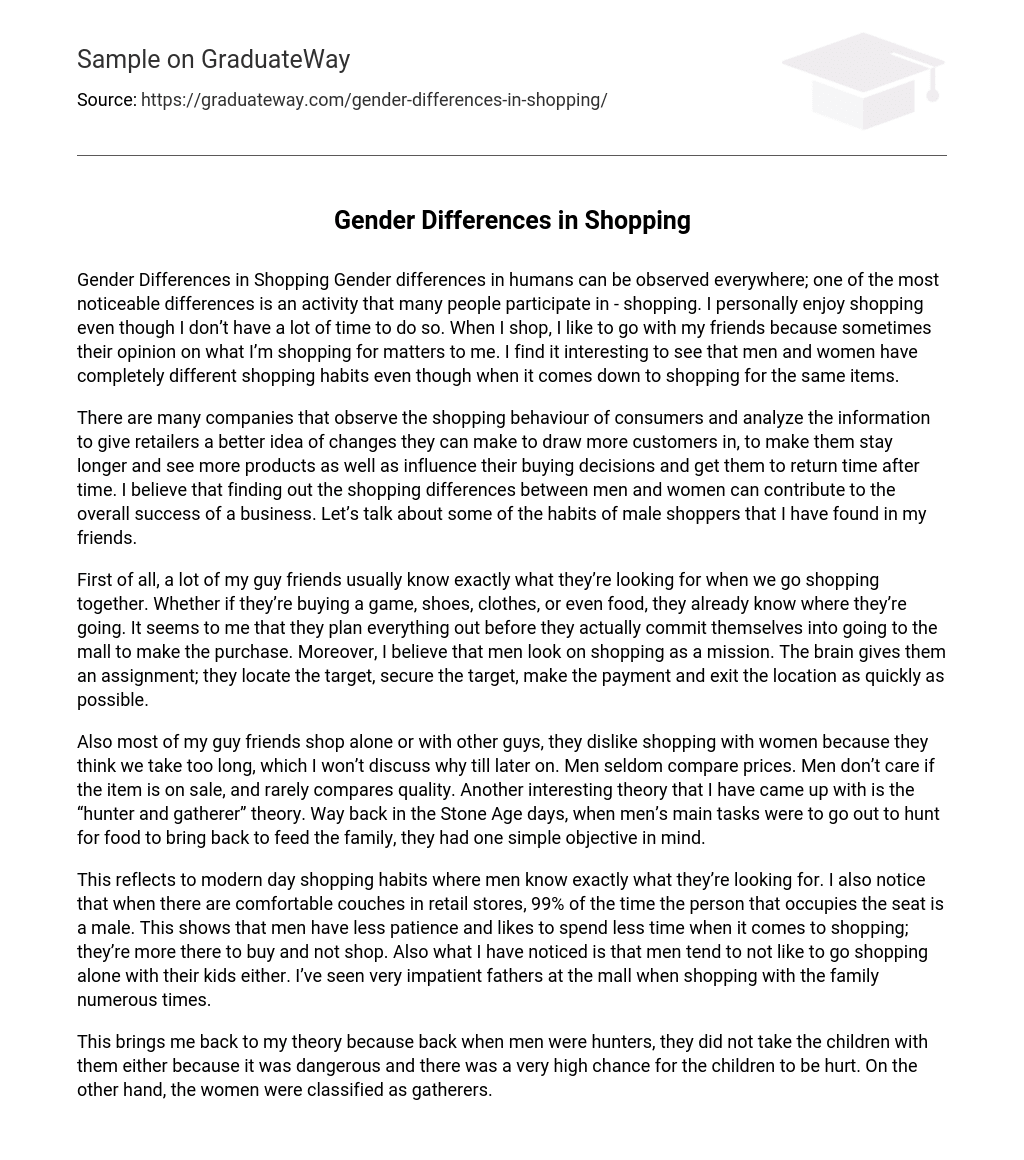Gender differences in shopping habits are often seen in humans, particularly when it comes to the activity of shopping. Personally, I derive pleasure from shopping regardless of time constraints. When I shop, I like having friends with me as their opinions on my purchases matter to me. It’s fascinating to witness the distinct shopping behaviors of men and women, even when purchasing the same items.
Consumer shopping behavior is closely monitored by numerous companies to help retailers attract more customers, prolong their visits, enhance product exposure, impact purchase decisions, and encourage repeat business. Analyzing the shopping patterns of both genders can greatly contribute to a company’s success. This article will specifically concentrate on the shopping habits of my male friends.
When I accompany my male friends on shopping trips, they usually have a clear goal in mind. Whether it’s buying a game, shoes, clothes, or even food, they always come prepared with a plan. It seems like they carefully strategize beforehand before going to the mall to make their purchase. From my point of view, men view shopping as an objective that demands meticulous steps: locating the desired item, ensuring its availability, efficiently completing the payment process, and promptly leaving the premises.
The majority of my male friends prefer shopping alone or with other males because they believe it takes longer when shopping with women. Later, I will explain the reasons behind this perception. Men rarely compare prices or show concern for sales or product quality. Furthermore, I have developed a theory called the “hunter and gatherer” theory which relates to men’s primary responsibilities in ancient times during the Stone Age: hunting for food to provide for their families.
The shopping habits of modern men reflect their clear preferences. Retail stores with comfortable couches are frequently occupied by men, indicating a desire to spend less time and be more focused on purchasing rather than browsing. Additionally, men generally do not enjoy shopping alone with their children and often become impatient at the mall when shopping with their families.
In the past, men refrained from bringing children along during hunting trips due to the associated risks and potential harm. Conversely, women took on the role of gatherers, collecting various items such as vegetables, fruits, plants, and more. When women went out for gathering purposes, they would do so in groups, turning it into a social event. Bringing their children along was customary for women during these gatherings.
Currently, a large number of women opt for group shopping as it provides an opportunity to socialize with friends, engage in conversation, and catch up. When I shop with my friends, we take our time exploring various stores and closely examining nearly every item. Personally, I derive great pleasure from selecting multiple outfits to try on in the fitting room. Despite these outfits sharing the same style, cut, and size, their colors differ. Hence, I eagerly try on each one to seek input from my friends. Moreover, I diligently compare my options based on factors like price, quality texture, and the approval of my friends.
Despite spending an entire day browsing, I often left without making a purchase. Working in a mall has made me realize that the majority of stores primarily serve women’s needs. There are more shops offering jewelry, cosmetics, and products exclusively for women compared to those catering specifically to men. Moreover, stores specializing in personal hygiene items primarily target women. Examples of such retailers include “Crabtree and Evelyn,” “The Body Shop,” and “Bath and Bodyworks.”
Despite lotions, soaps, and body washes being marketed to both genders, women are the main purchasers. Furthermore, stores that offer gender-neutral products usually have a larger variety of options targeted towards women rather than men. “La Senza,” exclusively selling undergarments and nightwear for women without any men’s products, is one such store. There are only a handful of other stores that solely concentrate on merchandise for men. Consequently, because of the availability of these specialized stores and choices customized to their preferences, women typically dedicate more time to shopping in comparison to men.
When compared to my male friends, I dedicate a greater amount of time to shopping due to the wide variety of products that I need to take into account. This encompasses not only clothing items like jeans, shirts, and dresses but also accessories such as earrings, necklaces, and makeup that can enhance my outfit or wardrobe. Conversely, men mainly concentrate on purchasing pants, shirts, and shoes. Additionally, women typically display a stronger inclination towards impulsive and emotional shopping in comparison to men.
There is a belief that shopping may be associated with a woman’s menstrual cycle, potentially serving as a means to deal with negative emotions resulting from hormonal fluctuations. Additionally, when feeling upset or depressed, engaging in shopping can frequently enhance one’s mood and overall state of being. Numerous women regard shopping as a form of therapy and partake in it during periods of emotional instability. The act of treating oneself to something special offers momentary relief from stress and unhappiness.
Women and men have distinct shopping behaviors. Women tend to be unaware of their spending until they receive their credit card bill after leaving the mall, potentially exceeding their limits. On the other hand, men usually plan in advance for mall trips and are less inclined to make impulsive purchases. Men consider shopping as a task aimed at obtaining something, whereas women perceive it as a social gathering and an occasion to spend time with friends and children.
The text explores the theory and reasoning behind the difference in shopping time between men and women. It proposes that women have more options compared to men, resulting in a wider range of products available to them. Additionally, it highlights how current shopping habits align with traditional gender roles, where men are hunters and women are gatherers. By acknowledging these gender-based differences in shopping behavior, retailers can effectively display and promote their products for maximum profitability.





